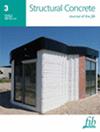Compressive behavior of sustainable rubberized concrete‐filled steel tube columns having various recycled tire rubber aggregate contents and developing a predictive design model
IF 3
3区 工程技术
Q2 CONSTRUCTION & BUILDING TECHNOLOGY
引用次数: 0
Abstract
As a sustainable solution, employing recycled tire rubber aggregates in the production of concrete is of considerable interest. However, the applicability of rubberized concretes in construction is restricted due to their relatively low mechanical performance. Using rubberized concrete as a filling material in a steel tube provides a suitable solution for overcoming this issue and for using it effectively as a load‐bearing element. The objective of this study is to examine the impact of the material characteristics of the sustainable rubberized concrete‐filled steel tube (Ru‐CFST) and develop a design model based on ultimate strength prediction for the axially loaded Ru‐CFST stub columns with varying contents of tire rubber aggregate. The model was developed through the gene expression programming (GEP) technique by employing the experimental test results to determine the ultimate compressive strength of Ru‐CFST columns. Based on the principal component analysis, the sectional properties of the load‐bearing element (such as outer diameter, thickness, and length), material strengths (such as rubberized concrete and steel tube strengths), and rubber content were determined as statistically significant parameters affecting the ultimate axial strength of Ru‐CFST stub columns and thus, they were considered in the stage of the model generation. Furthermore, the proposed model's performance was compared to that of available models suggested for traditional CFST columns by commonly employed design codes, namely, ACI, AIJ, AISC, CSA, EC4, and GB. Based on the statistical analysis of the results, it can be concluded that the existing formulations have a relatively acceptable randomness and scatter of observations within the distribution, while the proposed design model gives a more accurate prediction for the ultimate bearing capacity of axially loaded Ru‐CFST columns with the highest R‐squared value of about 0.99 and the comparatively lowest mean absolute percent error of 7.54. It can be stated that the proposed GEP‐based design model will encourage engineers to use such sustainable structural members in their designs and constructions.具有不同再生轮胎橡胶骨料含量的可持续橡胶混凝土填充钢管支柱的抗压行为及开发预测设计模型
作为一种可持续的解决方案,在混凝土生产中使用回收轮胎橡胶骨料引起了人们的极大兴趣。然而,由于橡胶混凝土的机械性能相对较低,其在建筑中的应用受到了限制。使用橡胶混凝土作为钢管的填充材料,为克服这一问题并将其有效用作承重元件提供了合适的解决方案。本研究的目的是研究可持续橡胶混凝土填充钢管(Ru-CFST)材料特性的影响,并根据不同轮胎橡胶骨料含量的轴向加载 Ru-CFST 存根柱的极限强度预测建立设计模型。该模型采用基因表达编程(GEP)技术,通过实验测试结果确定 Ru-CFST 柱的极限抗压强度。根据主成分分析,确定了承重元件的截面特性(如外径、厚度和长度)、材料强度(如橡胶混凝土和钢管强度)和橡胶含量是影响 Ru-CFST 柱极限轴向强度的重要统计参数,因此在模型生成阶段考虑了这些参数。此外,还将所建模型的性能与 ACI、AIJ、AISC、CSA、EC4 和 GB 等常用设计规范针对传统 CFST 柱所建议的现有模型进行了比较。根据对结果的统计分析,可以得出结论:现有公式具有相对可接受的随机性和分布内观测值的分散性,而所提出的设计模型对轴向加载 Ru-CFST 柱的极限承载力给出了更准确的预测,R 方值最高,约为 0.99,平均绝对百分误差相对最低,为 7.54。可以说,所提出的基于 GEP 的设计模型将鼓励工程师在设计和施工中使用这种可持续结构构件。
本文章由计算机程序翻译,如有差异,请以英文原文为准。
求助全文
约1分钟内获得全文
求助全文
来源期刊

Structural Concrete
CONSTRUCTION & BUILDING TECHNOLOGY-ENGINEERING, CIVIL
CiteScore
5.60
自引率
15.60%
发文量
284
审稿时长
3 months
期刊介绍:
Structural Concrete, the official journal of the fib, provides conceptual and procedural guidance in the field of concrete construction, and features peer-reviewed papers, keynote research and industry news covering all aspects of the design, construction, performance in service and demolition of concrete structures.
Main topics:
design, construction, performance in service, conservation (assessment, maintenance, strengthening) and demolition of concrete structures
research about the behaviour of concrete structures
development of design methods
fib Model Code
sustainability of concrete structures.
 求助内容:
求助内容: 应助结果提醒方式:
应助结果提醒方式:


